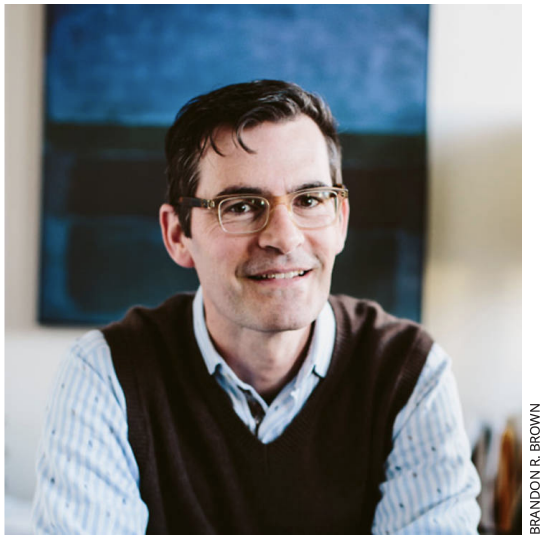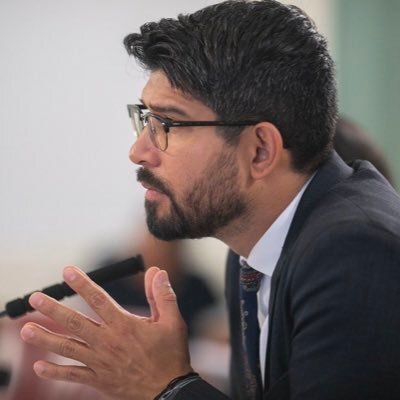 |
 |
Left: Branching diagram from a chalkboard at the Kavli Institute for Theoretical Physics in February, 2020. Right: KITP Writer-in-Residence, Brandon R. Brown.
Just over twenty years ago, a physics major approached me after class and said he had a non-physics question. Carlos, a bright, young man from Texas, had trekked to San Francisco for his college experience, pulled by our Jesuit university’s call to nudge, cajole, or push the world toward a more humane future.
“Dr. Brown? I like physics, and I definitely love your class.” He was ever polite, that kid. “But what does it mean for people? When can you see it changing people’s lives?”
At the time, at age thirty, I grappled with similar questions. I set down my stack of papers. “Physics has to take the long view,” I said. “Like, those physicists who once figured out how a semiconductor works, for no obvious reason? Nearly a century later, the world is transformed by computers and sharing information. That’s the best case. But then some studies won’t have much impact at all.”
I tried to summarize, not proselytize. “It boils down to whether or not you think it’s good and natural for us to learn as much as we can about the universe. And whether you believe that journey will do more good than it does harm.”
Carlos thought about this and wrinkled his brow. “I hear that,” he said. “I think I want to see something more direct though.” We talked about a change of major and what that would look like. He said he’d think it over. After shaking my hand – those innocent days – he left the lecture hall, and soon thereafter, he left the major with all my respect intact.
I recently thought of Carlos and his question again as I stood on a brittle bluff marking the edge of the Kavli Institute for Theoretical Physics, near Santa Barbara, California. You can look over miles of the Pacific Ocean, but it’s not as romantic as you would think. A chain-link fence keeps you back from the edge, and signs warn: “Cliffs undercut by erosion.” Just like Carlos’s question still gnaws at me, the metaphor of that cliff was only getting more obvious by the day. By late February, we knew the new coronavirus had much greater ambitions than Wuhan, though it still felt like a distant abstraction, just one of many mathematical conjectures. I was visiting the Institute as a “writer in residence” and aiming to chronicle a band of string theorists and black hole wranglers. (Professor Brown's Writer-in-Residence talk, below.) An ivory tower of brilliant but abstract geniuses sits literally steps from an encroaching, rising ocean. All the beautiful chalkboard diagrams and equations could someday be undercut by rising sea levels chewing the Institute’s foundations. What would Carlos say about my talented physics colleagues working away in there? Especially now, in a pandemic.
As I kept taking notes from the leading mathematical edge of physics, I had to ask Carlos’s question again in a less polite way: what good is this? Many of my biology pals are working around the clock, drawing and quartering the novel coronavirus, looking for weaknesses they can cleverly attack with drugs. Meanwhile, some of us are supposed to keep contemplating parallel universes, branching this way and that in lines of chalk? There’s just one universe right now, isn’t there? The one where doctors and nurses branch a single ventilator to support multiple sets of besieged lungs.
 Carlos Menchaca, far from his student days, still working to solve problems.
Carlos Menchaca, far from his student days, still working to solve problems.
I’ve often thought about theoretical physics and other abstract pursuits by viewing humanity as a sort of multi-celled organism. We can’t all be immune cells, protecting humanity from infection. Maybe theoretical physicists are a certain part of the brain matter, and maybe someone like myself, more of a communicator, is a nerve cell relaying signals from the brain to other parts of society’s body. When attacked by disease, a brain cell or a nerve cell can’t really uproot to join a fight in aching lungs. They can just do their jobs. And on cue, I open an email this morning from a theoretical physicist I’d met in Santa Barbara. In his email, there’s no mention of pandemic – just some follow-up about gravity and quantum theory. The show must go on, each cell to its purpose.
Going back to my talk with Carlos, I think of the long game again. Those biologist friends of mine, working feverishly on coronavirus drugs? They’re definitely using semiconductors for their daily online research meetings. In fact, as the world tries to keep lurching forward during lockdown, doctors can see patients, relatives can see newborn nieces, and grieving families can attend cremation rites, all through digital connections. Those are built on esoteric work of the 1930’s and 1940’s, when a few physicists drew their blinds against economic collapse and global war, scrawling away with pencil and paper. That’s when quantum theory, just a toddler, first cracked the code of semiconductors.
Looking to the next century’s pandemic, who’s to say that today’s crazy ideas for “quantum gravity” won’t have produced better tools, maybe a new type of microscope to dissect the next virus, or a revolutionary clean energy to keep hospitals running. Even in the moments this kind of long view makes sense, I admit it provides only cold comfort to the here and now.
These days, I’m not really in touch with Carlos Menchaca, the student who changed his major. One isn’t really in touch with the New York City council member, unless you’re a fellow city official or one of his constituents in District 38. But I follow him online. These days, he’s sharing COVID-19 resources on Facebook, trying to reach every segment of his district, in every language, with extra efforts for the most vulnerable. I don’t pretend that my attempt at an honest answer helped Carlos find this path – I don’t think anything would have altered that kid’s drive. But I’m grateful that his after-class question sticks with me. I hope that question can always keep people like me less comfortable than we’d otherwise be, as we cherish all those focused on the urgent now.
Post-script: After many years, I have just exchanged messages with Carlos; he actually liked a song I posted on Facebook, of all things. On reading the essay, he says he loves that “we are both holding that question close.” Despite his long daily work to effect change, he still likes to pull back for the big picture as well. He says he routinely looks at NASA-provided views of the Earth from space before he goes to bed. Thank you, Carlos, for all these perspectives. Much respect, as always.
Click above to play Writing the human stories of science: observations, and new questions, from a hybridized path or watch at https://online.kitp.ucsb.edu/online/resident/brown1/
- Brandon R. Brown, Professor and Chair of Physics and Astronomy, University of San Francisco and KITP Writer-in-Residence
KITP Newsletter, Fall 2020

